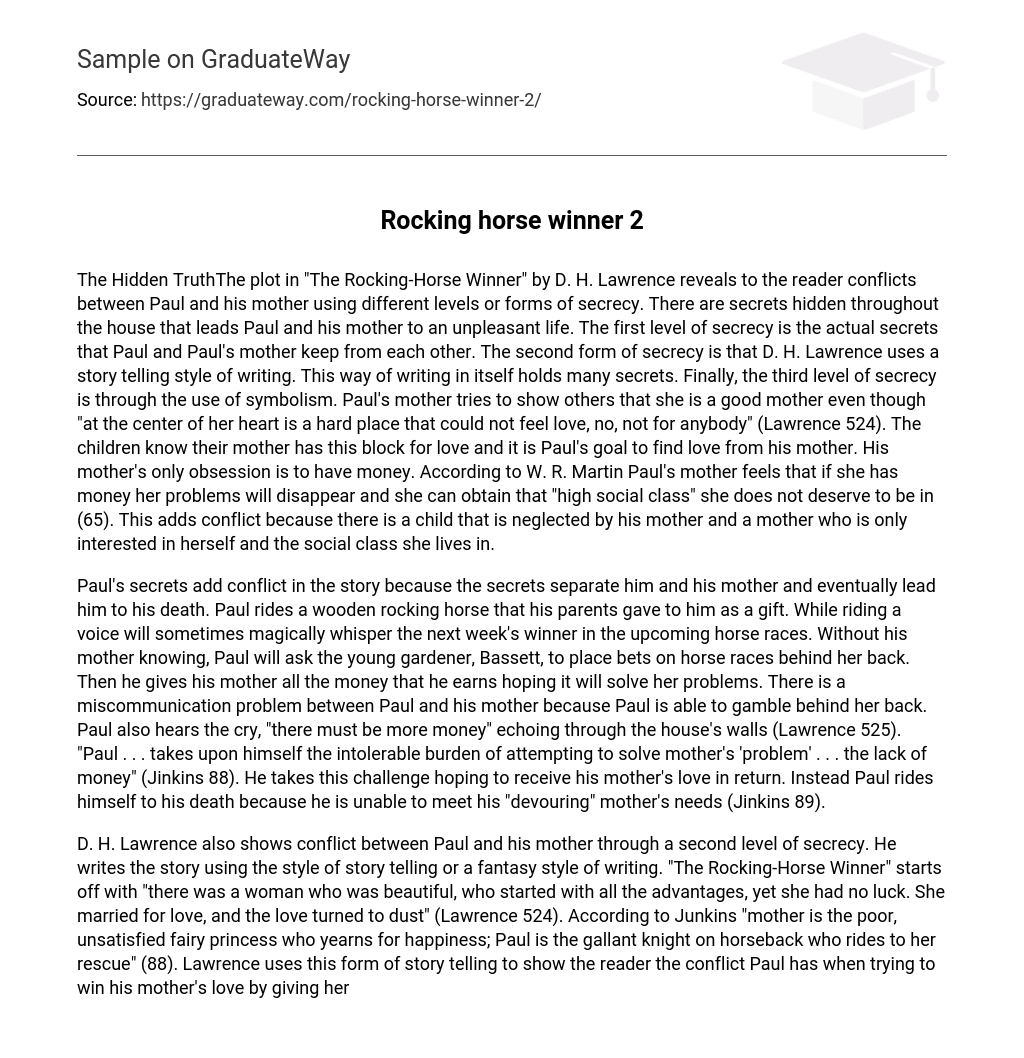D. H. Lawrence’s “The Rocking-Horse Winner” portrays conflicts between Paul and his mother through varying levels of secrecy. Both characters keep secrets from each other, creating a tumultuous household. Another form of secrecy is found in Lawrence’s storytelling style, which holds its own hidden truths. Additionally, symbolism adds another layer of secrecy to the narrative. Paul’s mother presents herself as a loving mother to others, despite harboring a coldness in her heart. Paul seeks love from his mother, who is solely obsessed with obtaining wealth and achieving a higher social status. This conflict arises from the neglectful behavior of the mother and her self-centered focus on social class.
Paul’s Secrets are a source of conflict in the story as they create a rift between him and his mother, ultimately leading to his demise. Paul possesses a wooden rocking horse gifted by his parents. While riding it, he occasionally hears a magical voice revealing the winners of upcoming horse races. Concealing this knowledge from his mother, Paul discreetly instructs the young gardener, Bassett, to place bets on his behalf. He then hands over all his earnings to his mother in the hopes of solving her financial troubles. The lack of communication between Paul and his mother arises due to his ability to secretly gamble. Moreover, Paul frequently hears the plea, “there must be more money,” resonating through the walls of their house. By assuming the burden of resolving his mother’s insatiable need for wealth, Paul seeks to earn her love. Unfortunately, instead of receiving affection in return, Paul’s relentless pursuit ends tragically as he fails to fulfill his mother’s voracious desires.
D. H. Lawrence portrays the conflict between Paul and his mother through a second layer of secrecy, utilizing a storytelling or fantasy style of writing. In “The Rocking-Horse Winner,” the narrative begins by introducing a beautiful woman who had all the advantages in life but no luck. She married for love, only to have that love disintegrate (Lawrence 524). Junkins suggests that the mother represents a dissatisfied fairy princess craving happiness, while Paul embodies a chivalrous knight who comes to her rescue. This storytelling approach allows Lawrence to illustrate Paul’s internal struggle to win his mother’s affection by showering her with wealth. The author also employs symbolism as a third form of secrecy. In one passage, Paul’s mother becomes aware of his obsession with the rocking horse when she switches on the light and sees him and herself illuminated in the doorway. This sudden enlightenment reveals Paul’s desperate zeal to reach his lucky place and the secrets he has been privy to all along. By referring to the rocking horse as wooden, Lawrence further symbolizes it as an embodiment of Paul.The wooden horse, resembling the horses Paul gambles on, is restrained by springs, symbolizing his mother’s stifling influence. Lacking love from his mother, Paul seeks it through his unusual obsession. When his mother witness his connection to the rocking horse, her greed overrides any affection, and she remains aloof in her shimmering attire, representing her cold-heartedness towards Paul.
In “The Rocking-Horse Winner,” D. H. Lawrence employs secrecy and symbolism in his choice of horse names. Lawrence includes the name Lancelot for the horse, which implies artificial love. Interestingly, this is the same horse that Paul loses his bet on. The irony lies in Paul’s belief that winning horse races and making money will earn him his mother’s affection, yet he loses his money and, as Paul perceives it, his mother’s love on a horse that represents artificial love. Additionally, Lawrence names one of the horses Daffodil, a flower known for its strong sexual connotations. Fitz defines Daffodil as a “sexually-charged flower.” It is noteworthy that Daffodil is the first horse on which Paul places his bet with Bassett. This irony arises from the fact that love is sometimes associated with sexuality. Therefore, Daffodil initiates a surge of emotions aimed at Paul’s quest for love from his mother.
D. H. Lawrence’s “The Rocking-Horse Winner” aims to evoke both emotional and intellectual disgust towards the soulless existence of a middle-class family. Lawrence employs various forms of secrecy to establish the story as a timeless classic, going beyond a simple plotline to delve into profound topics. The skillful depiction of conflicts between Paul and his mother through covert means showcases Lawrence’s remarkable storytelling ability. “The Rocking-Horse Winner” exemplifies Lawrence’s exceptional talent as a writer.
Works Cited
The source “Lawrence’s The Rocking-Horse Winner” by Beauchamp, Gorman can be found in the Explicator journal, volume 31, issue 5, from 1973. The source is identified as item 32.
Fitz, L. T. wrote an article titled “‘The Rocking-Horse Winner’ and The Golden Bough” which was published in Studies in Short Fiction in 1973 on pages 199-200.
Junkins, Donald. “‘The Rocking-Horse Winner’: A Modern Myth.” Studies in Short Fiction 2.1 (1964): 87-89.
Martin, W. R.’s “Fancy or Imagination? ‘The Rocking-Horse Winner'” is a paper published in College English in 1962, pages 64-65.
Steinbeck, John. “The Rocking-Horse Winner.” Modern Fiction Studies 9.1 (1965): 390-391.





